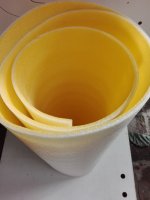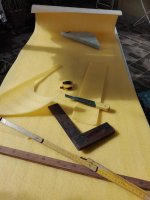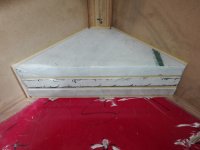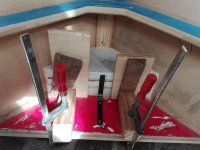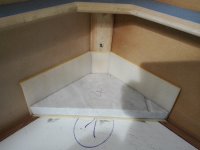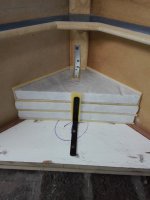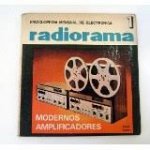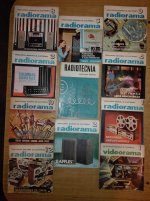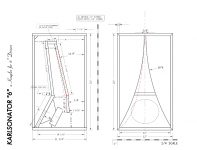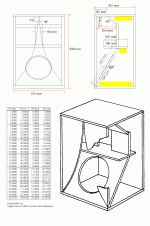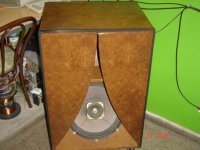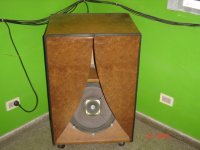The specific weight of sand is about half that of granite, 1.4 g/cc compared to 2.75 g/cc, but lead has more than 4 times the specific weight-11.36 g/cc.In addition, the specific weight of the sand is much lower than the marble, it would occupy more volume, which would reduce even more the available space, then, the Qts would increase.
Lead is a lot easier to cut than granite, and would reduce the Qts considerably for the same weight- but who's counting ;^).
The specific weight of sand is about half that of granite, 1.4 g/cc compared to 2.75 g/cc, but lead has more than 4 times the specific weight-11.36 g/cc.
Lead is a lot easier to cut than granite, and would reduce the Qts considerably for the same weight- but who's counting ;^).
Hi Weltersys
I thought of lead plates at some point.
It is sold by roll here, they are approximately 100 US $, the marble was free ......
The six pieces are already cut.
I have a question for everyone:
I know I would add rigidity to the panels if I apply a fiberglass / epoxy resin coating on the inside, but will I get some acoustic advantage?
Planchas De Plomo - Planchas Antiguas en Mercado Libre Argentina[A😛lanchas%20de%20plomo]
https://articulo.mercadolibre.com.a...&reco_id=dda2ca3e-9f02-407a-9999-527b5bef98ae
Last edited:
😕
This is so ? I would not have to worry about Young's module if I only want to play the first octaves, not more than 80/100 hertz .....
But I read somewhere that the MDF resonance is around 100 hertz, which confuses me, can the difference be so much?
Any thoughts to discuss / share?
Materiales para construcción de cajas - PCPfiles en www.pcpaudio.com
" MDF
The MDF is also quite cheap, although not as much as the agglomerate. It is very hard, and it works very well with hi ers glued with a special glue.
For a few years, the boxes are made with this material. It is three times cheaper than the cheapest wood and joining this to its hardness, rigidity and absorption rate make it a very suitable material to build boxes.
As a disadvantage, like all materials, it has a fixed Young's modulus and its behavior is not perfectly homogeneous and linear. It tends to resonate or reduce its absorption of sound around 200-400 Hz. This produces gray coloration. Many boxes suffer from this problem, since these frequencies are not attenuated with the materials that are commonly used (wool, fiberglass)
There are many descriptions of the sound of the MDF, basically all are summarized in a sound devoid of expressiveness and life, the band around 300Hz is very important to give body to the sound. Because of the structure of the sound and the wide range of frequencies of any of them, if a frequency fails, the sound is not perceived exactly the same "
This is so ? I would not have to worry about Young's module if I only want to play the first octaves, not more than 80/100 hertz .....
But I read somewhere that the MDF resonance is around 100 hertz, which confuses me, can the difference be so much?
Any thoughts to discuss / share?
Materiales para construcción de cajas - PCPfiles en www.pcpaudio.com
" MDF
The MDF is also quite cheap, although not as much as the agglomerate. It is very hard, and it works very well with hi ers glued with a special glue.
For a few years, the boxes are made with this material. It is three times cheaper than the cheapest wood and joining this to its hardness, rigidity and absorption rate make it a very suitable material to build boxes.
As a disadvantage, like all materials, it has a fixed Young's modulus and its behavior is not perfectly homogeneous and linear. It tends to resonate or reduce its absorption of sound around 200-400 Hz. This produces gray coloration. Many boxes suffer from this problem, since these frequencies are not attenuated with the materials that are commonly used (wool, fiberglass)
There are many descriptions of the sound of the MDF, basically all are summarized in a sound devoid of expressiveness and life, the band around 300Hz is very important to give body to the sound. Because of the structure of the sound and the wide range of frequencies of any of them, if a frequency fails, the sound is not perceived exactly the same "
Tesis de Resonancia
" Results
As years of study of Psychoacoustics and after so many experiments I can predict that MDF wood will vibrate in a range between 100Hz and 160Hz. The agglomerate will oscillate at the same values. The Polypropylene will be in the order of 500Hz and the same in the 1Khz. We'll see if one of our students determines it. Today the qualities of the MDF are discussed, it is said that from Asia there are two types, one with good alloy for acoustic enclosures and the other not recommended at all. With regard to the compound also called plywood, it remains indisputable with respect to its good results in the construction of loudspeaker boxes. "
😕🙄
" Results
As years of study of Psychoacoustics and after so many experiments I can predict that MDF wood will vibrate in a range between 100Hz and 160Hz. The agglomerate will oscillate at the same values. The Polypropylene will be in the order of 500Hz and the same in the 1Khz. We'll see if one of our students determines it. Today the qualities of the MDF are discussed, it is said that from Asia there are two types, one with good alloy for acoustic enclosures and the other not recommended at all. With regard to the compound also called plywood, it remains indisputable with respect to its good results in the construction of loudspeaker boxes. "
😕🙄

academia50 says:
" I would not have to worry about Young's module if I only want to play the first octaves, not more than 80/100 hertz .....
But I read somewhere that the MDF resonance is around 100 hertz, which confuses me, can the difference be so much ? 😕
Any thoughts to discuss / share ?
" I would not have to worry about Young's module if I only want to play the first octaves, not more than 80/100 hertz .....
But I read somewhere that the MDF resonance is around 100 hertz, which confuses me, can the difference be so much ? 😕
Any thoughts to discuss / share ?
Installed the marble blocks with 6 mm thick expanded polyethylene foam to avoid any kind of annoying vibrations.
🙂
Remember that the order of the photographs does not correspond to the order of work.
But it is quite close, with a little deduction you can follow the correct steps ....
😀
🙂
Remember that the order of the photographs does not correspond to the order of work.
But it is quite close, with a little deduction you can follow the correct steps ....
😀
Attachments
Resonances depends of the stiffness of the material and the size of it, so I don't know how you conclude that this 100Hz is the correct value for this case.
Resonances depends of the stiffness of the material and the size of it, so I don't know how you conclude that this 100Hz is the correct value for this case.
Hi Osvald
Yes, I agree with that, but the resonance is linked (I think) to the Young module, you can see in the attachments the values of the wood, among other materials ...
I imagine that different elasticities of materials, different resonances, but how to measure that I have no idea.
Hola Osvaldo
Si, estoy de acuerdo con eso, pero la resonancia esta ligada (creo) al modulo de Young, puedes ver en los adjuntos los valores de la madera, entre otros materiales ...
Yo me imagino que a distintas elasticidades de los materiales , distintas resonancias, pero cómo se mide eso no tengo idea.
Modulo de Young - Wikipedia, la enciclopedia libre
Anexo:Constantes elastoplasticas de diferentes materiales - Wikipedia, la enciclopedia libre
So I think the next stage is to make the "buco" for the speaker, put the stuffing, close and listen !
Así que creo que la próxima etapa es hacer el " buco " para el parlante, poner el relleno, cerrar y a escuchar !
Buco ( lunfardo argentino ) : Hole
Así que creo que la próxima etapa es hacer el " buco " para el parlante, poner el relleno, cerrar y a escuchar !
Buco ( lunfardo argentino ) : Hole
No recuerdo si Jorge Balsa o Julio Rueda recomendaban un método sencillo: colocando arena o algún polvo sobre la tabla, y excitándolo con señales de audio via un transductor (Parlante o algo así) veía los nodos y los vientres de la oscilación y los modos armónicos y sub de la misma.
I don't remember if it was Jorge Balsa or Julio Rueda who suggested to put sand or any other powder material over the table and excite it to see nodes and valleys of the mechanical resonance.
I don't remember if it was Jorge Balsa or Julio Rueda who suggested to put sand or any other powder material over the table and excite it to see nodes and valleys of the mechanical resonance.
Yo tambien compraba Radiorama ! 🙂 Tocaban temas muy variados, pero todo " a vuelo de pájaro ".
Para consultas de electronica " en serio ", consultaba el libro Radiotecnia del Ingeniero Ernesto Gaudioso. Muy completo, claro que aún no habían llegado los bits, la conversión de analógica a digital, ni las discusiones sin fin acerca de la superioridad sonora de los vinilos o del CD.
I also bought Radiorama! 🙂 They played very varied subjects, but everything "as the crow flies".
For electronic consultations "seriously", I consulted the book Radiotecnia del Ingeniero Ernesto Gaudioso. Very complete, of course, the bits had not arrived yet, the conversion from analog to digital, or endless discussions about the sound superiority of vinyl or CD.
Para consultas de electronica " en serio ", consultaba el libro Radiotecnia del Ingeniero Ernesto Gaudioso. Muy completo, claro que aún no habían llegado los bits, la conversión de analógica a digital, ni las discusiones sin fin acerca de la superioridad sonora de los vinilos o del CD.
I also bought Radiorama! 🙂 They played very varied subjects, but everything "as the crow flies".
For electronic consultations "seriously", I consulted the book Radiotecnia del Ingeniero Ernesto Gaudioso. Very complete, of course, the bits had not arrived yet, the conversion from analog to digital, or endless discussions about the sound superiority of vinyl or CD.
Attachments
speaking of Radiorama, I noticed the Internet Archive has a goodly amount as PDF
1972-10 has a labyrinth speaker project
(I'm looking for Karlson type)
Radiorama : Free Texts : Free Download, Borrow and Streaming : Internet Archive
1972-10 has a labyrinth speaker project
(I'm looking for Karlson type)
Radiorama : Free Texts : Free Download, Borrow and Streaming : Internet Archive
Sin embargo los de acústica eran bastante buenos (No el de Olson, pero buah).
Radiorama books about Acoustics were very good for me I learn very much from them.
Radiorama books about Acoustics were very good for me I learn very much from them.
speaking of Radiorama, I noticed the Internet Archive has a goodly amount as PDF
1972-10 has a labyrinth speaker project
(I'm looking for Karlson type)
Radiorama : Free Texts : Free Download, Borrow and Streaming : Internet Archive
There are quite a few Karlson pages, but in Spanish ... I can send them if you are interested
Sin embargo los de acústica eran bastante buenos
No el de Olson, pero buah
Radiorama books about Acoustics were very good for me I learn very much from them.
It is true, I learned a lot by reading the same ( me too) , although the TS parameters were not applied yet, the general info is very good.
Talk about Olson, what's the problem with him .....? 😕
Last edited:
No one problem with him. A pioneer. But several steps over our Saul Sorin 🙂
Here some material about Karlson's I searched time ago, and mines.
Here some material about Karlson's I searched time ago, and mines.
Attachments
Last edited:
No one problem with him. A pioneer. But several steps over our Saul Sorin 🙂
Here some material about Karlson's I searched time ago, and mines.
Osvaldo and freddi, here they have info that surely already they know but there are comments and interesting photos.
Caja Acustica Tipo KARLSON | Pagina 2 | Foros de Electronica
I was cheating. Say to those gilazos that he says "few means and highs" and "piped sound " that in the originals of Karlson he himself says that it is necessary to use speakers of extended range or coaxial, what a bunch of ********, they do not know nor to read.
As of 15" I didn't have (those of the photos are repaired units), I coaxed them myself with a 4 "tweeter in front of them.
Los estuve chusmeando. Decile al gilazo que dice "pocos medios y agudos" y "sonido entubado" que en los originales de Karlson él mismo dice que hay que usar parlantes de rango extendido o coaxiales. Que manga de pelotudos, no saben ni leer. Como de 15" yo no tenía (esos de las fotos son reenconados), los coaxiales me los hice yo mismo con un tweeter de 4" delante.
As of 15" I didn't have (those of the photos are repaired units), I coaxed them myself with a 4 "tweeter in front of them.
Los estuve chusmeando. Decile al gilazo que dice "pocos medios y agudos" y "sonido entubado" que en los originales de Karlson él mismo dice que hay que usar parlantes de rango extendido o coaxiales. Que manga de pelotudos, no saben ni leer. Como de 15" yo no tenía (esos de las fotos son reenconados), los coaxiales me los hice yo mismo con un tweeter de 4" delante.
- Home
- Loudspeakers
- Subwoofers
- Eminence Delta Pro 18 A in prism sealed 150 liters
